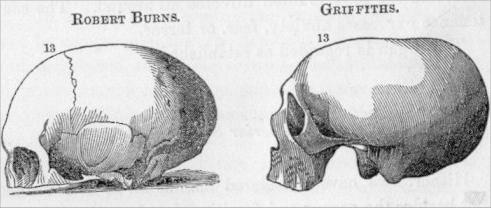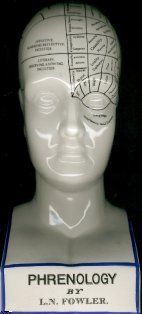[Adapted for the Victorian Web with the kind permission of the author from his extensive UK site on the History of Phrenology.]
"[Before phrenology] all we knew about the brain was, how to slice it..." — R. Chenevix (phrenologist),1828.
Phrenology was a faculty psychology, theory of brain and science of character reading, what the nineteenth-century phrenologists called "the only true science of mind." Phrenology was derived from the theories of the idiosyncratic Viennese physician Franz Joseph Gall (1758-1828). The basic tenets of Gall's system were:
1.The brain is the organ of the mind.
2. The mind is composed of multiple distinct, innate faculties.
3. Because they are distinct, each faculty must have a separate seat or "organ" in the brain.
4. The size of an organ, other things being equal, is a measure of its power.
5. The shape of the brain is determined by the development of the various organs.
6. As the skull takes its shape from the brain, the surface of the skull can be read as an accurate index of psychological aptitudes and tendencies.

So it was believed that by examining the shape and unevenness of a head or skull, one could discover the development of the particular cerebral "organs" responsible for different intellectual aptitudes and character traits. For example, a prominent protuberance in the forehead at the position attributed to the organ of Benevolence was meant to indicate that the individual had a "well developed" organ of Benevolence and would therefore be expected to exhibit benevolent behaviour.
However, like so many popular sciences, Gall and the phrenologists sought only confirmations for their hypotheses and did not apply the same standard to contradictory evidence. Any evidence or anecdote which seemed to confirm the science was readily and vociferously accepted as "proof" of the "truth" of phrenology. At the same time, contradictory findings, such as a not very benevolent and disagreeable person having a well-developed organ of Benevolence were always explained away. This was often done by claiming that the activity of other organs counteracted Benevolence. What was never accepted by phrenologists, however, was that admitting that the activity of a particular faculty could be independent of the size of its organ undermined the most fundamental assumptions of the science- and thereby rendered all of its conclusions inconsistent and meaningless.
From Britain phrenology spread to America and France in the 1830s and in the1840s
it was re-introduced to Germany. It became far more successful in America. Phrenology
died away in Britain by the early 1850s but a new movement was re-introduced
to Britain by the American "phrenological Fowlers" in the 1860s and
1870s. The Fowlers had begun lecturing and reading heads for fees in New York
in the 1830s. Their phrenology was wholly borrowed from the British modifications
of Gall's system. The Fowlers swept through Britain on a successful lecture
tour before establishing various phrenological institutions, societies and publishing
concerns. Less scientifically pretentious and more overtly entrepreneurial,
it is largely this latter-day phrenology whose remnants are still seen today.
A phrenological bust in an antique shop will almost invariably bear the label
"L. N. Fowler". The latter phrenology movement was largley responsible
for the  anthropometric
(head reading) craze of the latter 19th century and its well-known anthropological/racial
concerns. The early phrenological movement was concerned more with providing
practitioners with claims to epistemological certainty and intellectual authority
than disscussing human races.
anthropometric
(head reading) craze of the latter 19th century and its well-known anthropological/racial
concerns. The early phrenological movement was concerned more with providing
practitioners with claims to epistemological certainty and intellectual authority
than disscussing human races.
Phrenology evolved into wider and wider cultural space over time, beginning
with Gall and the highest scientific and social and cultural elites, from Goethe
to the king of Prussia, to the British and American scientifically pretentious
middle-class phrenological societies of George Combe and finally to the disreputable
practical "professors" of phrenology, reading heads for profit and
the mass audiences of the Fowlers to the dawn of the 20th century. So-called
"practical" phrenologists like the Fowlers, far outnmubered, in the
long run, the interested medical men, the scientifically pretensious and theoretical
phrenologists. Many orignal texts are available at this site which portray a
broad range of phrenological literature- from high brow to low brow.
During phrenology's first heyday in the 1820s-1840s, many employers could demand a character reference from a local phrenologist to ensure that a prospective employee was honest and hard-working. This belief that the protuberances on the skull provided an accurate index of talents and abilities was particularly urged to be applied to education and criminal reform. Phrenologists, not unlike those who today believe in strong demarcations in "left-" or "right-brains", thought they could determine the most suitable career for the young and match prospective mates with greater accuracy than 'old-fashioned love'. Visiting a phrenologist was akin to seeking the advice of so-called psychics, clairvoyants or astrologers today. A phrenologist was someone who claimed to have access to special knowledge about people. The ignorant and gullible were particularly susceptible to the pretensions of phrenologists.
Rather than portraying phrenology as having succumbed to an inexorable progress of 'science' or representing the Victorians as having become less 'gullible', phrenology can be understood to have been diffused and absorbed into a host of other practices and traditions- as such many of its components live on. Alison Winter uses a similar approach to understand the 'disappearance' of mesmerism. Phrenology, as all popular fads, eventually became deeply unfashionable amongst the well-to-do who had previously espoused it. It had degenerated into a sect of zealous extremists. Many of the first generation phrenologists were unable to pass on their discredited knowledge to a new generation which had many more opportunities to participate in popular sciences. Nevertheless, the British Phrenological Society (founded by L.N. Fowler in 1887) was only disbanded in 1967.
Related Material
Last modified 2000